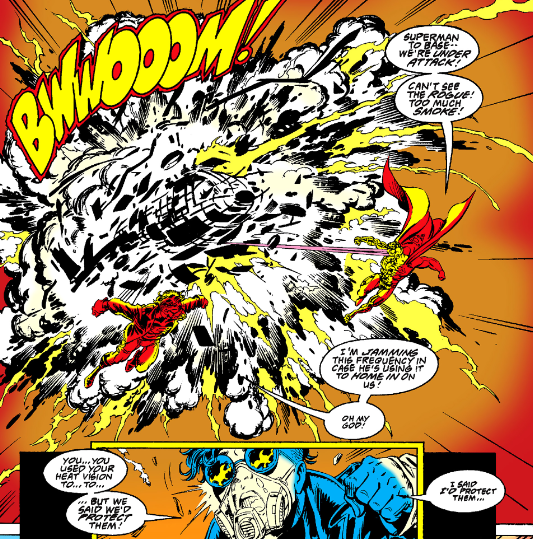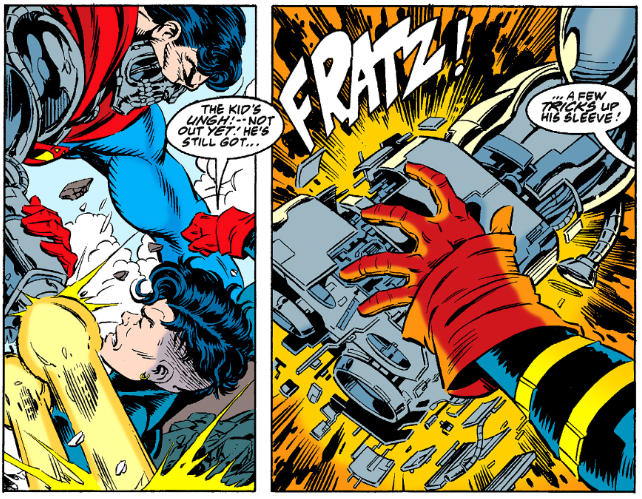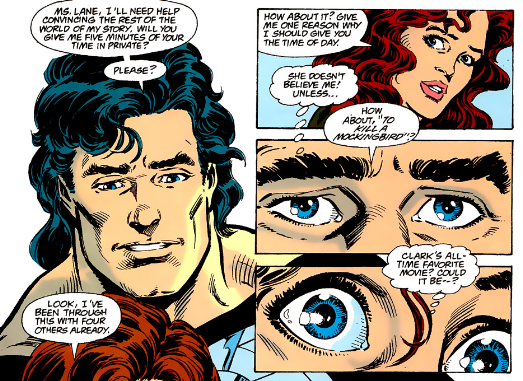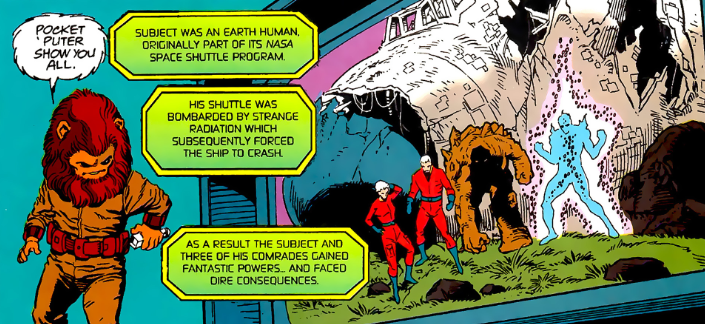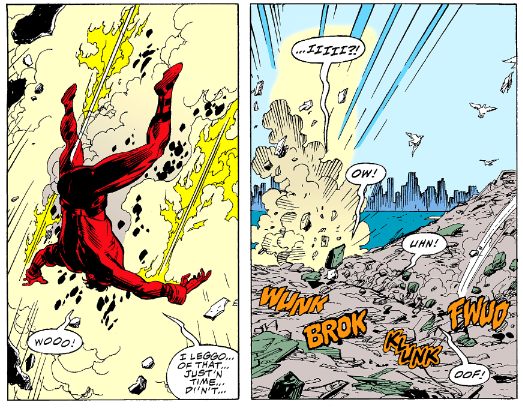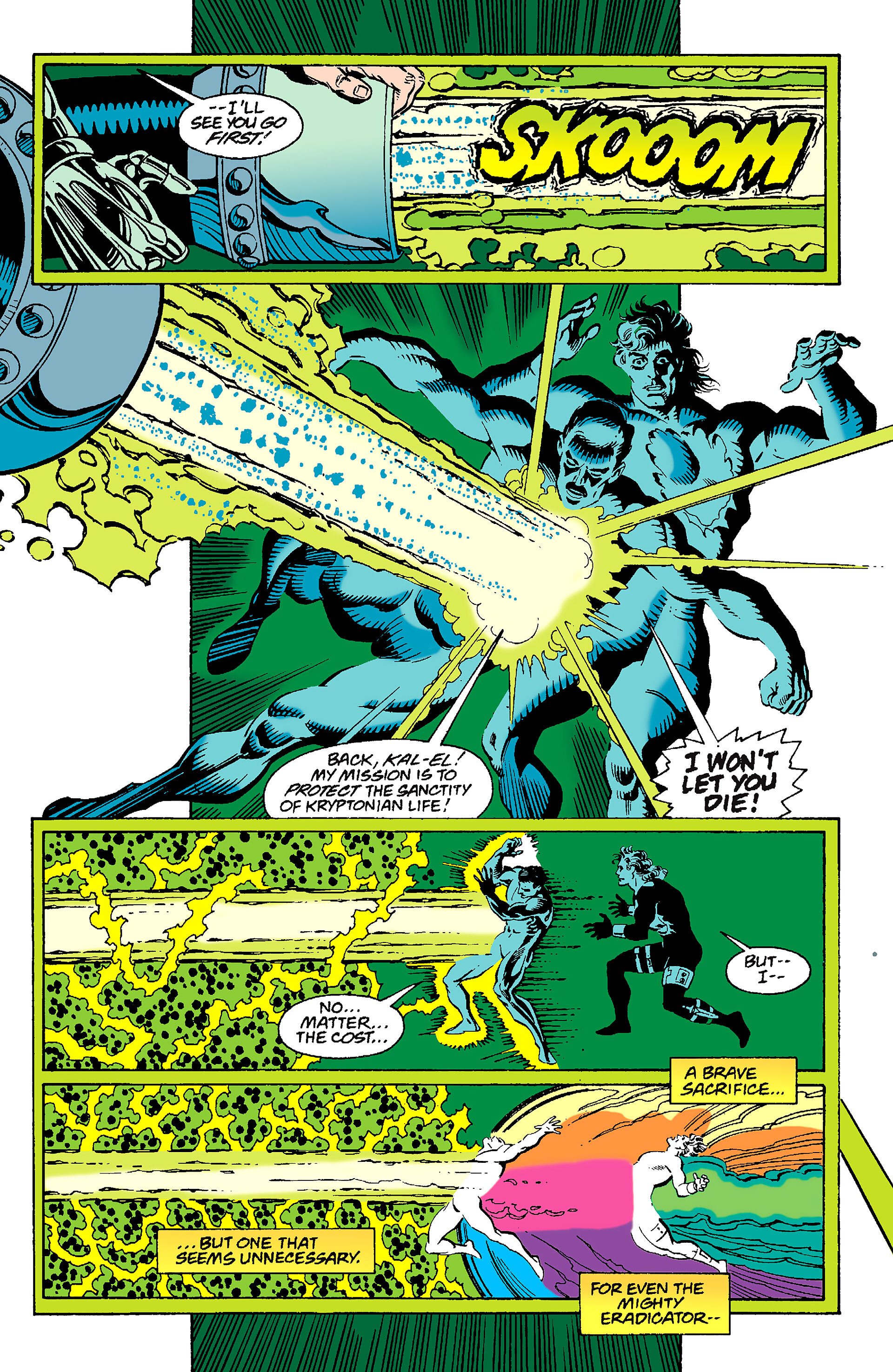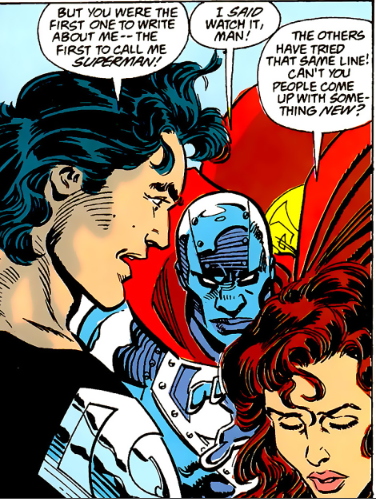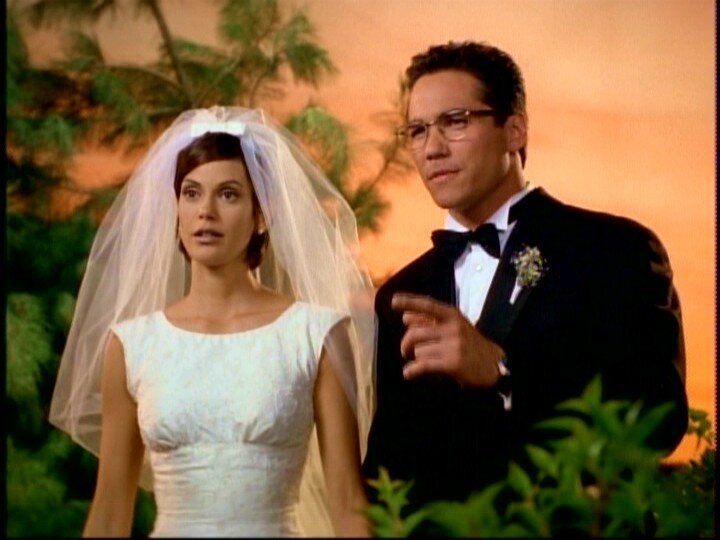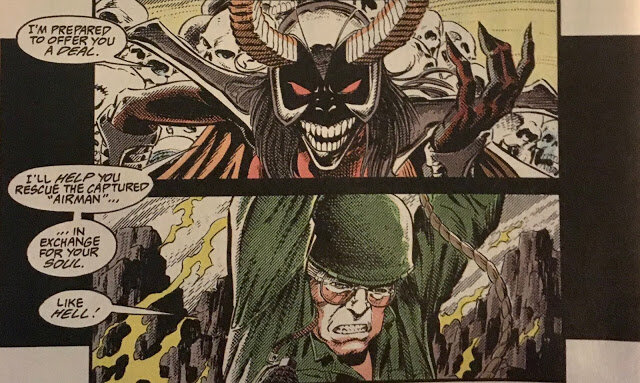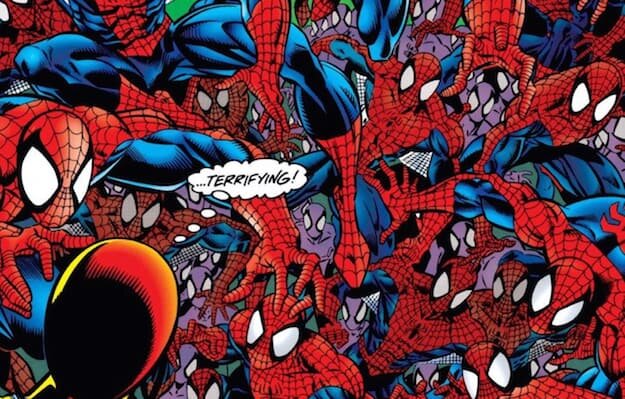The Death of Superman Retrospective IV: The Return of Superman // Comics History 101
Finally, Superman had returned. Fresh off his Death in 1992, the Man of Steel was back… four times over. As we covered last time, Superman had four successors to the cape. The Cyborg, a Terminator-inspired fusion of flesh and machine. Superboy, a younger imperfect clone of the Man of Steel. The Last Son, an energy-blasting merciless killer. Steel, a man with a suit of armor dedicated to Justice.
And, now, a fifth had joined them, nicknamed for the purposes of this article as Superman Black.
Also, the Cyborg Superman and an alien spacecraft obliterated Coast City, as well as striking perhaps a lethal blow against the Last Son. This would have massive repercussions outside of the pages of Superman, though most fans remember this almost as well as the Death of Superman. Now that Coast City has been wrecked, and a new structure in place, the Cyborg "Superman" resumes his cover as the real successor to Superman. Flying over the devastated Santa Barbara, he locates a few survivors who were able to somehow escape the devastation of the previous issue. The Cyborg explains that the Last Son turned traitor and wiped out all life around them, and look out, he's behind you!
Meanwhile, a massive purple robot leaves the Fortress of Solitude, lurching off into the ocean and stomping along the ocean floor towards Metropolis.
Speaking with his White House contact, the Cyborg requests the young Superboy join him in search and rescue efforts. A small reporter crew from WGBS, Superboy's exclusive news station, has chosen to tag along with the Cyborg and the Clone to document what happened to the bustling community. The Cyborg warns them he might not be able to protect them, and they would likely die in there.
And they do. The Cyborg is nothing if not true to his demented word, it seems. Superboy tries to take down the robot, and the two discover the young clone has a new talent: the ability to disassemble things at a touch.
Unfortunately, the surprise doesn't avail the Boy of Steel, and the Cyborg beats him into unconsciousness.
The ripped open Fortress of Solitude is once more populated, as a critically injured Last Son crashes into the Antarctic construct. As we saw last time, the matrix crystal that the Last Son was recharging himself on shattered to reveal a fifth Superman. With the crystal opened, Superman Black gone, and the Last Son alone, the robots try to find a way to heal the damage caused by the Cyborg and Coast City's destruction.
The Cyborg, master of technology, contacts the Justice League with a fake image of Superboy by his side. They claim that the Last Son was really a scout for an alien armada, and said Superman and his ship have left for space, leaving behind a destroyed city. So, believing the word of the Cyborg and Superboy, they fly off into space in order to catch those allegedly responsible.
And, outside of another major player, that would be the last of the Justice League for this story.
Sigh.
Now that the Last Son has been placed in a healing chamber, the robots that work in the Fortress of Solitude to repair the body… and the mind. As it turns out, the Last Son is not the revived Clark Kent. Much like how Superboy is a recycled character concept of "Superman as a young man," the Last Son is a completely recycled character. His name?
The Eradicator.
For those who just asked, "wait, who?", it's certainly understandable. The Eradicator had shown up at the start of Louise Simonson's launch of the Man of Steel book in 1991. A holdover of Kryptonian civilization, he was intended by Kryptonian scientists to keep their civilization on Krypton. Should one leave, the Eradicator would give them a deadly weakness to the element lead. Jor-El was able to cure this in baby Clark before sending him to Earth. The Eradicator was a machine before taking near-human form and eventually tried to possess Clark to force Earth into a Kryptonian form. While Clark had burned him out by flying into the sun, it was thought the Eradicator had been wiped out. Obviously, it had survived and wandered back to Earth in time to claim a copy of Clark's body as its own.
Superboy is able to escape what is now Engine City, a massive rocket engine intended to make the planet Earth fly through space as a new "War World." He arrives back at Metropolis just in time to meet Steel, Supergirl, and Lois Lane, all encountering the massive purple Kryptonian battle armor coming out of the ocean. Through a supreme effort, Steel winds his hammer back and-
-cripples the battlesuit with a single blow. As everyone talks about how the Cyborg is the real villain, and how he plans to take down Metropolis, the battlesuit opens and leaks out fluid as a figure drops out.
Superman Black has arrived in Metropolis, and his time in the battlesuit has somehow grown his hair out into what has become jokingly called the Super-Mullet. This was added literally because the artist responsible for the issue wanted to change up Clark’s hairstyle. He's also swapped out the traditional Kryptonian raiment for a black Superman outfit with silver highlights. The traditional red and yellow shield is also silver, and he even has silver toe guards for reasons best known to the artists. A brief grab to the shoulder by Steel has Superman Black wincing in pain, and it seems like Black is a bit more vulnerable than even Superboy has been. However, the newest incarnation of the Man of Steel also knows quite a lot more about Clark's life outside the cape.
When I first read this story through assorted individual issues as a kid, this sealed it for me that Superman Black was the real deal, that Clark had somehow come back from the dead. However, reading it in collection form, this rather wonderful moment is completely undercut by Lois being utterly neutered during the original four's premiere. It still comes off well but feels less poignant than it did when I was a kid missing those key issues.
Now that the Eradicator's backstory has been handed out, a pair of aliens living in Engine City is now about to pull another massive exposition dump, this time for the Cyborg Superman. It took only a few panels to explain how the Eradicator had come back, who he was in the first place, and how he accidentally became a copy of Superman, but this expositional dump takes place over a fourth of Superman 81. It is admittedly welcome to explain how and why the Cyborg is the way he is but ultimately feels like someone in editorial demanded a lengthy explanation as to who this guy was.
The Cyborg is Hank Henshaw.
Again, I'm a fair amount of fans who had begun reading with the Death and Return at the time just went "wait, who?" over this revelation. I know I certainly was just as confused. However, Henshaw had appeared as part of a jab against the Fantastic Four back in 1990. In the pages of Superman 42 and Adventures of Superman 465, a group of astronauts went up into space and came back distorted by cosmic radiation. One of the crew is turning into burning radiation and chooses to fly into the sun to end his life. Another member is changing into earth minerals and chooses to end his suffering in the hospital's MRI machine.
Henshaw himself is melting away to nothing more than a skeleton and uses the last ebbs of his life to spare his wife, who was phasing into another dimension. A few issues later, it turns out Henshaw didn't die and somehow evolved into an electronic consciousness. His wife ends her life in a fit of insanity once he reveals himself to her, and he flees the planet in a commandeered piece of Kryptonian tech. This all happened on the pages of the comic but had been discarded or left as another piece of abandoned plot for another writer to pick up on later.
As it turns out, they chose to pick up on this guy sooner than anyone expected. As the expositional aliens continue, they explain how Henshaw encountered Mongul, who was once in charge of a massive mechanical planet called a War World, until Superman dismantled it. Agreeing to work together, Mongul will get his revenge on Superman, and the Henshaw will get his revenge on the world that ruined his life and family.
With the pieces in place, it's time for the remaining Supermen to go to Engine City and try to take the Cyborg down. Superman Black borrows a pair of rocket boots from a Team Lex trooper, and the three remaining heroic Supermen fly off across the country to take down the Cyborg.
All three crash the party that is Engine City, smashing themselves right into the middle of a group of guards and armed soldiers. The fight is brief, and Superman Black realizes that he's going to need more than just his lackluster powers or relying on luck. Instead, Superman Black mentions offhand that he's always considered a Boy Scout, so he might as well be prepared.
Superman’s return from the dead also granted him a degree in 90s superhero fashion, aka POUCHESPOUCHESPOUCHESPOUCHES-
It is cheesy and corny as hell, but it is also somehow awesome at the same time. During another round of combat, the trio of Supermen stumbles across a massive missile aimed at Metropolis! As it turns out, rather than sending the spaceship over to Metropolis, Mongol has built an inter-continental ballistic missile loaded with tech to not only blow up Metropolis but also somehow build a second engine atop the ruins. While Superman Black and Steel are able to escape the missile's exhaust range, Superboy has gone missing.
Oh, there he is. The missile rockets to Metropolis in a matter of pages and Superboy has crawled to the front of the missile. With a super-human level of effort, he is barely able to push the missile away from the city.
Luckily, Death has currently lost all meaning in this story thanks to the five different Supermen who have shown up claiming to be him. I'm fairly sure that Superboy will be replaced soon by the Boy of Steel, the Boy of Tomorrow, the Last Boy of Krypton, and even the Metropolis Tot to push this event out to ridiculous levels.
Luckily, he did actually survive and landed in the Metropolis city dump.
Meanwhile, Superman Black and Steel are falling down to the core of Engine City. Somehow, Superman Black is able to slow his fall before lading. Are his powers returning? Is it possible he's actually the real deal? Well… not quite. It turns out Supergirl has snuck along and has been hiding invisible and pitching in here and there. This genuinely undermines some of the case made for Superman Black being the real deal.
While it's obvious that DC is setting up Superman Black as the actual returned-from-the-dead Clark Kent, it also feels incredibly weird that the book is still taking the time to question this. Steel doesn't think he could be the real thing due to his lack of powers, Superboy doesn't care, and Lois is somehow jaded from the other Supermen having shown up a few weeks prior. It really feels dishonest, that someone is trying their best to keep audiences guessing despite the fact that this should be the point where someone should be considered the heir apparent to Superman's mantle, or has returned, to take up arms against the Cyborg Superman.
For those reading at the time, audiences had to take a detour out of the Superman books and into Green Lantern #46. As mentioned multiple times before, the generically-named Coast City was Hal Jordan's hometown and often where his civilian identity hung his hat when he wasn't running around the universe as Green Lantern. Hal had spent a bunch of time out in space arguing and fighting with fellow space-cops the Darkstars and the L.E.G.I.O.N., and DC had made an event out of it, calling it Trinity. Now that Hal was back home, however, he had found that his city had been destroyed, and replaced with a massive space engine.
Of course, as mentioned in previous articles, this issue is written by Gerard Jones. Who is serving time for possession of child pornography.
At this rate, maybe I should write about Jones’ Green Lantern run. I can always have more fun taking the guy down a lot of pegs.
So, aside from the issues of a massively troublesome creator and being tied in with another comic's major storyline, Green Lantern 46 takes the time to resolve the whole Coast City subplot in an issue. Hal Jordan charges in and rescues Superman from being beaten to Death by Mongol. Hal then beats Mongol down using some enhanced ring-based armor and Steel's hammer. However, issue 82 of Superman features a briefer version of this issue, so you can feel free to work around supporting Jones if you're getting these issues individually.
Superman Black, Supergirl, and Steel all run further into Engine City, trying to make their way to the core where Henshaw the Cyborg is hiding. However, the Cyborg seems to be playing for time. He zaps Superman Black's chest, burning away the S, and then takes over the scraps of Steel's armor and almost kills him.
I don’t know why he didn’t do this to Steel earlier. Or ever again.
Superboy and the Eradicator both… just show up in Engine City again. Superboy saves Steel with his weird telekinesis, and the Eradicator looking completely different. No one really questions this, weirdly. With just Superman Black and the Eradicator all alone against the Cyborg, the Eradicator takes the time to explain that this resurrection was totally a one-time deal and that Superman really couldn't survive dying again, and that he totally was dead.
Amusingly, Superman would later die in New 52’s Last Days of Superman, DC Universe vs the Masters of the Universe, Superman/Batman, as well as Wonder Woman/Superman. And would be fine each time.
It feels like someone in editorial was trying to make a promise about how Superman wasn't cheating Death, and that this couldn't happen again for any other hero. Unfortunately, it also feels like a case of over-explaining. This entire storyline has been about Superman dying, how people totally miss him once he's dead, and then bringing him back in a way that doesn't feel like a cheap cop-out. With the Cyborg being evil, Superboy being continually hinted at to not just be a clone of Superman, and the Last Son being the Eradicator, it just feels like the book should have doubled-down the minute Superman Black showed up instead of continually asking questions and making everyone doubt him.
The book also seems to be getting rushed now to make Superman "return" because Superman 82 is also the final issue in this saga. It turns out that the Cyborg has been luring the Eradicator and Superman into the depths of Engine City because it's powered by Kryptonite. Superman seals them all in to keep everyone else safe from the radiation, and the Eradicator and Superman try their best to take Henshaw down. It doesn't work. Instead, the Cyborg rips a tube free from the wall and sprays Superman and the Eradicator with Kryptonite. Not thinking, the Eradicator dives in front of Superman to save him.
Somehow, the Kryptonite flying through the Eradicator's body changes the nature of the deadly material. Instead of killing the recently-revived Clark Kent, this rainbow of Kryptonite actually re-powers Superman back to his old self again. From there, the original Superman drives his fist through the Cyborg's body and shatters it into a million pieces. The original Superman has returned, and the telekinesis of Supergirl restores his original outfit of red and blue.
Wikipedia claims they would “darken” the blue on Superman’s costume to show how he was “forever changed.” It’s the exact same shade as it was when he died, the same shade also found on Superboy and Supergirl. Marketing!
And with that, Superman was back and alive again, complete with extra mullet. He would figure out how to further revive Clark later, by having the shape-changing Supergirl pretend to be Clark, who was totally buried in the rubble during the Doomsday fight and not actually Superman.
Both Superboy and Steel would actually get their own solo books and would become long-running supporting heroes in their own right. The Eradicator, despite becoming a burned corpse, would somehow fuse with a STAR Labs scientist into a confusing and convoluted character that really didn’t make sense. This… guy would lead the Batman-related superhero group The Outsiders for a while. The Cyborg also would not be finished here and would return a few years later with the Superman story Hunter/Prey that tried to give a plausible backstory to Doomsday while the monster ravaged Darkseid's Apokolips.
The Super-Mullet would also remain, though it would be lost during the experimental comics that were the Electric Superman period… and that in itself is a grand and bizarre tale for another day.
To be honest, this final fourth is where a lot of the story just falls apart. By establishing the returning Supermen as all fakes with a fifth and previously unknown Superman stepping in to take the cape, it feels like the creators wasted months of page space establishing how "real" and "true" they were in the first place. It creates this awkward lackluster ending where Superman's return isn't a grand event but instead feels like just a mandatory plot point with the actual ending having been lost to the trash bin.
But the biggest damage actually wasn't done to Superman's comics at the time. With all the pomp, circumstance, and marketing hype barreling at investors and readers alike during 1992/1993, the very concept of Death and finality itself in comics arguably became cheapened like nothing else. Major comic deaths have never been as hyped since, and almost none of the deaths that have happened in any major capacity have bothered to stick.
Peter Parker's Spider-Man (three freaking times). Bruce Wayne's Batman. Steve Rogers' Captain America. Wolverine. Cyclops (twice). Jean Grey (again). Ollie Queen's Green Arrow. Hal Jordan's Green Lantern. Bart Allen's Flash. Wally West's Flash. Tony Stark's Iron Man. Jim Rhodes' War Machine.
Even aunt May Parker came back from her emotional 1994 death before the decade was out.
All of these heroes have died since Superman came back from the grave, and fans all kept counting the books until they came back. Hell, we've even had long-standing deaths undone, like Bucky Barnes and Barry Allen.
This isn't to say that comics have had a great track record with keeping someone dead before Superman. Guys like Charles Xavier kept faking their Death until it became parody back in the sixties, while Jean Grey returned from the Death as a marketing stunt for Marvel's then-new X-Factor in 1988. But someone as big as Superman being killed off, and DC playing this straight-faced with the public at large basically shot themselves in the foot when it came to Superman himself. I have not been able to come up with concrete sources. However, one Chris Sims (formerly of Comics Alliance) worked at comic shops and distinctly remembers people coming by years and decades later, wondering why Superman was still being published if he was dead.
The Death and Return of Superman is fantastic when it comes to how the Man of Steel dies. It's mediocre when it comes to remembering who he was and missing him. When the impostors all fly in, the comic does a lot of interesting things, with some genuine character examinations. But when Clark Kent himself comes back to life with more than enough evidence to prove that he is the real deal?
Doubt. Fear. Wariness. And readers were losing interest without a simple straight answer as to who Superman's successor was. The bump in sales DC had taken from the Death slumped during the return, and to make matters worse, the whole reason for the delay in te marriage, the Lois and Clark TV series?
They wouldn't marry until October 1996, in an episode titled “Swear to God, This Time We’re Not Kidding.”
The series would also be cancelled at the end of the 1996/1997 season. Something tells me a show sold on the family-friendly sexual chemistry of Lois and Clark just doesn’t survive when the “will they / won’t they” is resolved.
The comics cast would finally be allowed to marry that year as well, with the delay of the wedding simply having the excuse of "life is weird when you're Superman." That's it.
I have a lot of nostalgia for the Return of Superman. The designs, while drastically 90s, are all solid and wonderful. The concept of removing the main character to examine what happens when they're dead is also great. However, the execution turns out to be one of the more middling results in the long run. But here's the thing: do all of these issues need to be read, especially today?
Not really.
The Death of Superman just isn't a good example of modern Superman comics. It's about how he fights and dies and is built as such, though it shows his core character's strength throughout. Funeral for a Friend is overall lackluster but does include the excellent Adventures of Superman 500. Again, that is a wonderful issue to pick up if you can.
The final run, featuring the Reign and Return? It becomes remarkably middling and muddy as the books both refuse to work with one another and tie in together in ways that should work but often don't, and other ways that shouldn't work but do. It's great that Superman got to come back from the grave without dragging the story out. Still, it almost feels like the ending for this story was just a set up to keep as many characters as possible while also letting Green Lantern get a new status quo that hopefully won't make any of his readers irate.
Which it completely failed at, amusingly.
In a way, the Death and Return have become akin to Marvel's Clone Saga: a massive tale that winds through all the character's comics at the time, replace the character with a new character (or four) and end with none of it having mattered in the first place. The aftermath even obsesses with over-explaining the few subtleties of plot that remained, with an entire issue dedicated with Lois and Clark being told that, hey, Jonathan's Bogus Journey was all 100% real.
Which makes Jonathan Kent more badass in retrospect, but also undermines the feel of the story.
However, Superman has been in far worse comics and been saddled with far stranger gimmicks. As a whole, it's worth reading for those curious. But there are over 80 years of comics, with a lot of them being much more enjoyable.
Sometimes, a story just exists. While the Death of Superman is an excellent experiment, and great for the era it comes from, as well as an introduction of so many iconic characters and concepts… the story just falls flat in execution of the ending.
But hey, at least it wasn't as bad as the Clone Saga.



